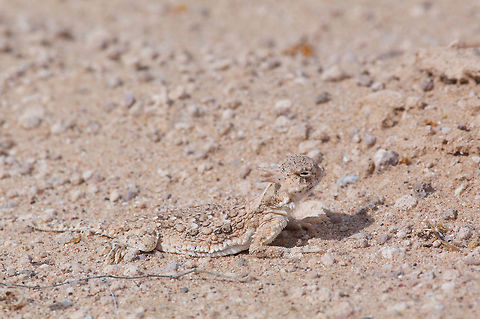
Appearance
A medium-sized (up to about 95 mm or 3.75" from snout to vent), exceptionally flat and wide lizard. Thick, spike-like scales project from the back of the head. The two central head spikes (occipital horns) project up and back, and are noticeably longer than the other spikes. The bases of the occipital horns are not in contact with one another. Several isolated, pointed scales project from the back. Each lower side of the body is edged with one or two fringes of enlarged, pointed scales. A row of enlarged, pointed scales projects from each side of the throat. Base coloration is tan, gray, or brown and usually matches the soil on which the lizard lives. The lower edges of the body are often infused with salmon, peach, or orange. A pair of large dark blotches marks the neck and the back is often adorned with paired dark blotches. The rear of edge of each body blotch is often outlined with white or cream. The venter is often maked with sparse dark flecks which are more dense and prominent on the anterior venter and throat.Distribution
This lizard is distributed across Arizona southwestern basin deserts south of the Gila River at elevations ranging from near sea level along the Colorado River to about 610 m (2,000'). It also occurs in northwestern Sonora, Mexico.Behavior
This diurnal ground-dweller is most active in the morning and evening. It seeks shelter from the high mid-day temperatures by burying itself in the soil or retreating into an existing burrow. When encountered it is more likely to run than our other horned lizards but it often stops under the nearest bush. When captured it may inflate itself by gulping air, poke with the horns, and flatten the body into a disc shape.Habitat
In Arizona this desert-dweller inhabits the Lower Colorado River Valley subdivision of Sonoran Desertscrub. It is usually encountered in relatively flat, open, areas with sandy or loamy soil and is less frequently encountered on rocky bajadas and foothills.References:
Some text fragments are auto parsed from Wikipedia.
http://www.reptilesofaz.org/Lizards-Subpages/h-p-goodei.html